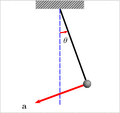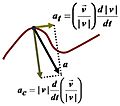Acceleration facts for kids
Acceleration is a measure of how fast velocity changes. Acceleration is the change of velocity divided by the change of time. Acceleration is a vector, and therefore includes both a size and a direction. Acceleration is also a change in speed and direction, there is:
Speed (a scalar quantity) (uses no direction)
- Distance is how far you traveled
- Time is how long it took you to travel
- Speed is how fast you are moving - Speed = Distance / Time
Velocity (a vector quantity) (uses a direction)
- Displacement is how much your position has changed in what direction
- Velocity is how quickly your position is changing and in what direction
- Velocity = Displacement / Time
The measurement of how fast acceleration changes is called jerk.
Contents
Examples
- An object was moving north at 10 meters per second. The object speeds up and now is moving north at 17 meters per second. The object has accelerated.
- An apple is falling down. It starts falling at 0 meters per second. At the end of the first second, the apple is moving at 9.8 meters per second. The apple has accelerated. At the end of the second second, the apple is moving down at 19.6 meters per second. The apple has accelerated again.
- Jane is walking east at 3 kilometers per hour. Jane's velocity does not change. Jane's acceleration is zero.
- Tom was walking east at 3 kilometers per hour. Tom turns and walks south at 3 kilometers per hour. Tom has had a nonzero acceleration.
- Sally was walking east at 3 kilometers per hour. Sally slows down. After, Sally walks east at 1.5 kilometers per hour. Sally has had a nonzero acceleration.
- Acceleration due to gravity
Finding acceleration
Acceleration is the rate of change of the velocity of an object. Acceleration  can be found by using:
can be found by using:
where
 is the velocity at the start
is the velocity at the start is the velocity at the end
is the velocity at the end is the time at the start
is the time at the start is the time at the end
is the time at the end
Sometimes the change in velocity  is written as Δ
is written as Δ . Sometimes the change in time
. Sometimes the change in time  is written as Δt.
is written as Δt.
In difficult situations, the acceleration can be calculated using mathematics: in calculus, acceleration is the derivative of the velocity (with respect to time),  .
.
Units of measurement
Acceleration has its own units of measurement. For example, if velocity is measured in meters per second, and if time is measured in seconds, then acceleration is measured in meters per second squared (m/s2).
Other words
Acceleration can be positive or negative. When the acceleration is negative (but the velocity does not change direction), it is sometimes called deceleration. For example, when a car brakes it decelerates. Physicists usually only use the word "acceleration".
Newton's second law of motion
Newton's laws of motion are rules for how things move. These rules are called "laws of motion". Isaac Newton is the scientist who first wrote down the main laws of motion. According to Newton's Second Law of Motion, the force something needs to accelerate an object depends on the object's mass (the amount of "stuff" the object is made from or how "heavy" it is). The formula of Newton's Second Law of Motion is  , where
, where  is the acceleration,
is the acceleration,  is the force, and
is the force, and  the mass. This formula is very well-known, and it is very important in physics. Newton's Second Law of Motion, in short "Newton's Second Law", is often one of the first things that physics students learn.
the mass. This formula is very well-known, and it is very important in physics. Newton's Second Law of Motion, in short "Newton's Second Law", is often one of the first things that physics students learn.
Deceleration
Deceleration is negative or backwards acceleration. This means that something slows down instead of speeding up. For example, when a car brakes, it is decelerating.
Images for kids
-
Components of acceleration for a curved motion. The tangential component at is due to the change in speed of traversal, and points along the curve in the direction of the velocity vector (or in the opposite direction). The normal component (also called centripetal component for circular motion) ac is due to the change in direction of the velocity vector and is normal to the trajectory, pointing toward the center of curvature of the path.
See also
 In Spanish: Aceleración para niños
In Spanish: Aceleración para niños





